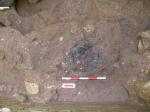Interpretation
-
- Fill of crucible cut
-
- Megan McNamee
- 6-7-2010
Stratigraphic Relationships
- No Linked Records
Site Photo
Description
- color, composition
- trowel
- Dimensions from 2010:rnN-S: 1.00 m; E-W: 0.61 m; diameter of circular burn area: 0.38 m; depth: 0.33 mrnDimensions from 2008:rnE-W: 0.43 m; N-S: 0.53 mrnrn
- sandy burnt earth
- orangey black
- loose
- good
- artificial
- pebbles, clay (the dark brown "burnt" clay cakes), fragments (some large some tiny) of a cream-colored stone
- ash, carbon, tufa
- brick fragments, ceramic fragments
- Concentrated area of burnt material filling cut 3170 in the west area of the chapel near column base. The context fills a nearly perfect circular pit in which the fill is completely burnt. The charred (though less thoroughly burnt) area outside the cut (rife with flecks of carbon, same composition, less burnt) also counted in this context.
- The northern and southern limits of the context were difficult to discern. The dimensions might be have been reduced in the removal of 3141 (MM 2008). The context was left exposed for two years, further reducing the limits of the context. The earth was actually quite sticky, but made sandy by the abundant of presence of decaying tufa (MM: 2010).
- good
Ceramic Inventory
- 400 AD - 699 AD
- calabrian-sicilian wine amphorate [late 4th-7th]
| Total fragments | |
|---|---|
Basic Information
- Surface burn area in west area of the chapel near column base
Record Details
- Lovisa Brannstedt
- 18-7-2007
